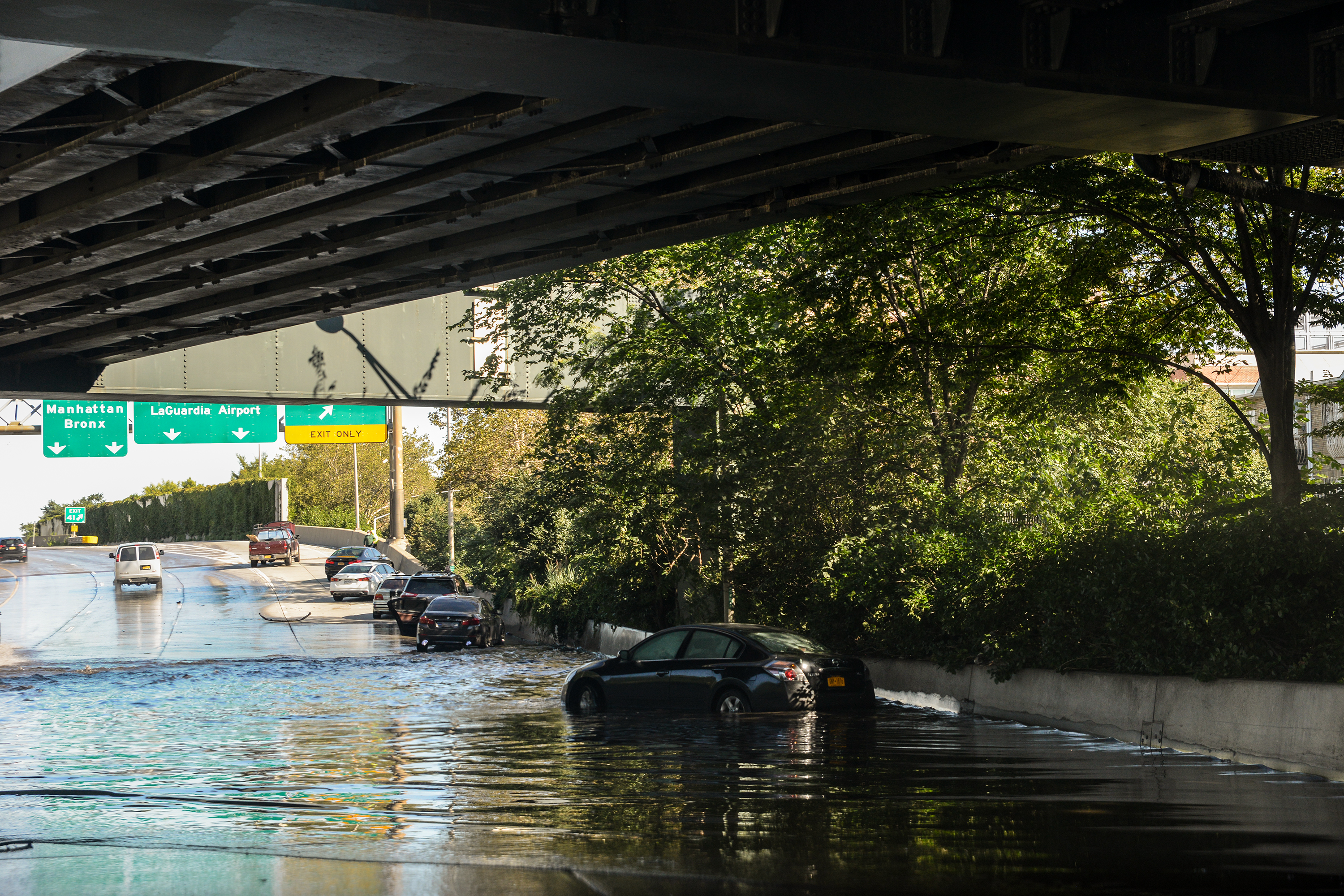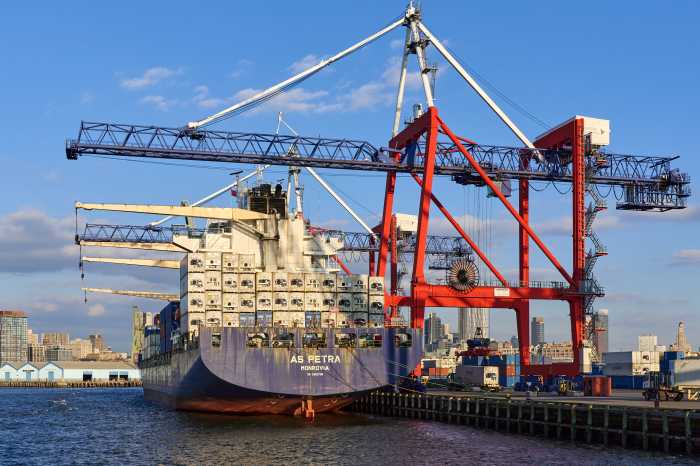This article was originally published on by THE CITY
At least 13 people were killed across Brooklyn and Queens on Wednesday as record-breaking rains pummeled the city overnight, revealing weaknesses in the city’s infrastructure and planning following the second historic weather event in less than two weeks.
Coming just 12 days after Tropical Storm Henri dumped previously unseen amounts of precipitation on New York, Ida has proven the urgency for the city and state to tackle climate change as a life-or-death issue.
Of the confirmed fatalities, 11 died when water rushed into their basement apartments and trapped them inside, according to the police department. One man was also found dead inside his car on the Grand Central Parkway on Thursday morning, according to the police department, and another man was found floating, fully clothed, in the Gowanus Canal in Brooklyn.
A 2-year-old boy was the youngest person to die when his parents couldn’t escape from their Woodside basement apartment, according to officials and neighbors.
The parents called the owners of the three-story home, who lived on the top floor, and begged for help, said Deborah Torres, who lives in the first floor apartment of the home and also experienced flooding.
“It was so fast I didn’t have time to do anything,” she said. Just below her, water rushed in quickly up to the ceiling of the basement apartment, where a 50-year-old man and his 48-year-old wife couldn’t escape with their son.
“The pressure of the water was too strong,” Torres said.
Focus on Preparation
As much as three inches fell within a single hour in some locations, surpassing records set by Henri just weeks earlier.
Torrential waters brought subway service to a halt, left vehicles abandoned on deluged highways from the Long Island Expressway in Queens to the Major Deegan in the Bronx, and flooded basements — many of them occupied apartments.
A spokesman for the police department said they had towed 500 abandoned vehicles as of Thursday afternoon, with many more still left on highways and roads.
The NYPD conducted rescues across the city, with 28 on Staten Island, 20 in Queens, 13 in the Bronx, five in Brooklyn and three in Manhattan.
Of the rescues in Queens, 18 were at the U.S. Open at Flushing Meadows-Corona Park, according to Chief Rodney Harrison.
There were also 69 water rescues, including one man who was on top of a box truck on the Brooklyn-Queens Expressway, Harrison said.
City and state officials at a news conference in Hollis, Queens, Thursday morning vowed to investigate why the storm caused so much chaos.
Gov. Kathy Hochul, who became governor last week on the heels of Henri and now faces her first major weather crisis, said the state and city needed to do a better job of warning people about these severe weather events.
“We need to foresee these in advance, and be prepared,” she said, calling for a report on government failures.

Mayor Bill de Blasio called the record rainfall “the biggest wakeup call we could possibly get” about the need to fortify against extreme weather, adding: “It’s time for an entirely different approach.”
“Let’s be blunt about it: We saw a horrifying storm last night, unlike anything we have seen before,” he said. “And this is a reality we have to face.”
De Blasio also described his administration as lacking advance warning of just how destructive Ida’s remnants would be.
“We’re getting from the very best experts, projections that then are made a mockery of in a matter of minutes,” he said. “We need to start communicating to people that we should assume things are going to be much worse in literally every situation. Yesterday morning, the report was three to six inches over the course of the whole day, which was not a particularly problematic amount that turned into the biggest single hour of rainfall in New York City history with almost no warning.”
Henri Contrast
In contrast with Henri, which caused minimal damage in the five boroughs and landed largely east and north of the city, advance public warnings from local and state authorities about Ida’s risks were minimal.
While former Gov. Andrew Cuomo had declared a state of emergency a day in advance of Henri’s landfall and asked the Biden administration for an emergency declaration before the storm hit, Hochul’s declaration came at 1:42 Thursday morning, after transit riders and motorists had been stranded and homes flooded with feet of water.

At his daily media briefing Wednesday morning, de Blasio mentioned anticipated rain only briefly, announcing an expected three to six inches. More than 7 inches ultimately fell in Central Park. Hochul directed state agencies to prepare emergency responses for the rainfall Wednesday morning, her office announced in a press release as her administration turned its attention to pressing business in Albany: an extension of New York’s eviction moratorium.
The rain that washed over the city had been warned about for days, said a meteorologist for the National Weather Service in New York, and emergency managers had been briefed several times a day about the onslaught of rain.
“The signs were here all week for a significant rain event,” meteorologist James Tomasini told THE CITY. “Yesterday the Weather Prediction Center had us at a pretty rare high risk of excessive rainfall for our area, which is pretty rare to see.”
Weather tracking records warned in the dawn hours of Monday morning that New York was likely to face excessive rain mid-week and with flash floods likely. The National Weather Service issued a Flash Flood watch for the region by Monday afternoon and a day later heightened the tri-state area’s outlook to high risk of excessive rain, comparing it to to Hurricane Isaias last year, which left 2.5 million people in the New York City area without power, and tropical storm Lee and Hurricane Irene of 2011, which walloped parts of upstate New York and left cities flooded with feet of water.
A spokesperson for the governor did not immediately comment on the state’s preparedness.
911 Deluged
Just across from where Hochul, de Blasio and other officials spoke, a 22-year-old man and his 45-year-old mother had been killed when their basement apartment flooded. The rush of water caused the foundation of the home to collapse, ripping a hole in the side and making it more difficult to rescue them, according to the FDNY.
Rescuers pulled the woman out from neck-deep water and began CPR but she later died at the hospital, officials. Her son was later found dead inside.
“Sometimes I think I’ve seen everything, but not last night,” Fire Commissioner Daniel Nigro said of the historic flooding and rainfall. He said calls were coming from all across the city for rescues.

The city’s 911 emergency call system was overwhelmed, with many callers being put on hold until call takers were available, according to a source at the city’s tech department.
The NYPD, which operates the system, asked the approximately 400 call takers on the day shift to work another tour to handle the expected increase, according to Ralph Palladino, second vice president of District Council 37’s Local 1549, the union representing the call takers.
The system was still understaffed during the storm because some people were unable to make it into work because of widespread subway outages, he added.
The union has pressed the mayor and the City Council to add funding for between 200 to 500 new call takers.
“We have empty desks,” Palladino said.
‘It’s a Sewer Issue’
The city has invested $2 billion in fixing long standing problems with sewers and flooding in southeast Queens, but there is still more work needed, de Blasio said.
“That investment is having an impact but it’s not complete,” de Blasio said. “It’s been going on for years, it will take some more years to finish in terms of the impact investments here in this immediate area.”
Department of Environmental Protection Commissioner Vincent Sapienza said his agency would do a “full hydraulic assessment” but the rain quickly overwhelmed its sewage systems.

“Rainfall rates were really extraordinary and far exceeded the capacity of the system,” he said. “Anything over two inches an hour, we’re gonna have trouble.”
Neighbors on 183rd Street said they’ve faced persistent flooding and sewer backups on the block for years, and haven’t received much help from the city.
“This has been going on our entire life,” said Jennifer Mooklal, 33, who lives in a single-family home with her extended family. There are sewer issues and floods at least five times a year, especially in the summer.
“For politicians and the governor to say that it’s global warming, it’s not global warming,” she said. “It’s a sewer issue that they don’t want to acknowledge.”
Mooklal said DEP came to do construction work there recently, which crew members told her was to increase the size of the sewer “but it clearly didn’t work.”
On Wednesday night, she had to climb through her living room window to get into her house, as floodwaters trashed the home’s basement and part of the first floor.
Her father, Abdol Hack, said once he saw the water had reached as high as his outside fence, which is a few feet tall, he knew it was too late.
“There’s nothing you can do then,” he said.

 A man pushes a car through a flooded street in Brooklyn.
A man pushes a car through a flooded street in Brooklyn. City, state and federal officials hold a press conference on 183rd Street in Hollis, Queens, following the death of multiple neighbors in Wednesday night’s flooding. Sept 2, 2021.
City, state and federal officials hold a press conference on 183rd Street in Hollis, Queens, following the death of multiple neighbors in Wednesday night’s flooding. Sept 2, 2021. Delivery workers in Astoria toiled in waist-deep water for less than minimum wage as the remnants of Hurricane Ida poured over the region Wednesday night.
Delivery workers in Astoria toiled in waist-deep water for less than minimum wage as the remnants of Hurricane Ida poured over the region Wednesday night. The 207th Street train yard in Manhattan was flooded by Ida. Sept. 2, 2021.
The 207th Street train yard in Manhattan was flooded by Ida. Sept. 2, 2021. The Brooklyn Queens Expressway near the Northern Boulevard exit in Jackson Heights. Sept. 2, 2021,
The Brooklyn Queens Expressway near the Northern Boulevard exit in Jackson Heights. Sept. 2, 2021, A flooded parking lot in Marble Hill. Sept. 2, 2021.
A flooded parking lot in Marble Hill. Sept. 2, 2021. Downed branches being cleared in Central Park. Sept. 2, 2021.
Downed branches being cleared in Central Park. Sept. 2, 2021.THE CITY is an independent, nonprofit news outlet dedicated to hard-hitting reporting that serves the people of New York.







































